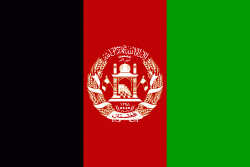Mir Samir (Mayrsmayr)
Mir Samir, also called Mir Simir, is a mountain in the Hindu Kush in Afghanistan. The first unsuccessful attempt to climb it was in 1959 despite a local tradition that it was unclimbable. The English traveller Eric Newby and the diplomat Hugh Carless attempted to climb Mir Samir in 1956, but they could not reach the main peak, as described in the book A Short Walk in the Hindu Kush.
Mir Samir lies on the east side of the upper Panjshir Valley, Afghanistan and the border of Nuristan. It is about 90 miles (150 km) due north of the city of Jalalabad as the crow flies, and more practically about 100 miles (160 km) northeastwards up the Panjshir Valley from the town of Charikar.
Until 1966, Mir Samir was thought to be 19,878 ft (6,059m) high, but its height has been revised down to 19,058 ft (5,809m).
Afghanistan was surveyed by the British during the Second Afghan War of 1878–1880. However the surveyors had to work under fire, and were unable to cross the Hindu Kush. The surveyor Mr. Scott was able to climb the 15,620 ft mountain Sikaram in the Safid Koh, from where he noted to the north "a pyramid standing far above the heads of all the surrounding peaks of the Hindu Kush". The mountaineer Boleslaw Chwascinski writes that this was "most probably" Mir Samir.
Mir Samir lies on the east side of the upper Panjshir Valley, Afghanistan and the border of Nuristan. It is about 90 miles (150 km) due north of the city of Jalalabad as the crow flies, and more practically about 100 miles (160 km) northeastwards up the Panjshir Valley from the town of Charikar.
Until 1966, Mir Samir was thought to be 19,878 ft (6,059m) high, but its height has been revised down to 19,058 ft (5,809m).
Afghanistan was surveyed by the British during the Second Afghan War of 1878–1880. However the surveyors had to work under fire, and were unable to cross the Hindu Kush. The surveyor Mr. Scott was able to climb the 15,620 ft mountain Sikaram in the Safid Koh, from where he noted to the north "a pyramid standing far above the heads of all the surrounding peaks of the Hindu Kush". The mountaineer Boleslaw Chwascinski writes that this was "most probably" Mir Samir.
Map - Mir Samir (Mayrsmayr)
Map
Country - Afghanistan
 |
 |
| Flag of Afghanistan | |
Human habitation in Afghanistan dates back to the Middle Paleolithic era, and the country's strategic location along the historic Silk Road has led it to being described, picturesquely, as the ‘roundabout of the ancient world’. Popularly referred to as the graveyard of empires, the land has historically been home to various peoples and has witnessed numerous military campaigns, including those by the Persians, Alexander the Great, the Maurya Empire, Arab Muslims, the Mongols, the British, the Soviet Union, and most recently by a US-led coalition. Afghanistan also served as the source from which the Greco-Bactrians and the Mughals, amongst others, rose to form major empires. The various conquests and periods in both the Iranian and Indian cultural spheres made the area a center for Zoroastrianism, Buddhism, Hinduism, and later Islam throughout history.
Currency / Language
| ISO | Currency | Symbol | Significant figures |
|---|---|---|---|
| AFN | Afghan afghani | Ø‹ | 2 |
| ISO | Language |
|---|---|
| PS | Pashto language |
| FA | Persian language |
| TK | Turkmen language |
| UZ | Uzbek language |















